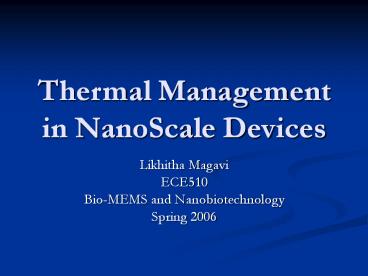Thermal Management in NanoScale Devices - PowerPoint PPT Presentation
1 / 15
Title:
Thermal Management in NanoScale Devices
Description:
The graph shows the comparison of different methods investigated to reduce leakage. ... Fabrication of Electrowetting actuator. Chrome patterned bottom glass plate. ... – PowerPoint PPT presentation
Number of Views:125
Avg rating:3.0/5.0
Title: Thermal Management in NanoScale Devices
1
Thermal Management in NanoScale Devices
Likhitha Magavi ECE510 Bio-MEMS and
Nanobiotechnology Spring 2006
2
Overview
- Introduction
- Prior Work Approach
- New Research Latest Advances
- Preferred Technique
- Experiments and Results
- Application
- Conclusion
3
Introduction
- Thermal issues in IC design
- - Over heating
- - Temperature vs Performance
- - Temperature vs Circuit Reliability
- Figure 1 Power consumption
- vs temperature for 130-nm
- technology.
- Figure 2 Power consumption vs temperature for
65-nm technology.
Image source Supply and Power Optimization in
Leakage-Dominant Technologies, IEEE TRANSACTIONS
ON COMPUTER-AIDED DESIGN OF INTEGRATED CIRCUITS
AND SYSTEMS, VOL. 24, NO. 9, SEPTEMBER 2005
4
Temperature Effect !
- Figure 1 Leakage current vs Frequency of
operation. - The graph shows the comparison of different
methods investigated to reduce leakage. - Decrease in temperature gives 30X-40X reduction
in leakage.
5
Prior Work Approach
Cause for heat conduction - The hot spot issue.
- Proposed cooling techniques
- - Figure 1 Heat sinks on the back of a
silicon chip substrate. - - Figure 2 Heat pipes.
- - immersing the electronic chips in
a pool of inert - dielectric liquid .
- Application incompatibility .
Image Source Christian Belady "Cooling and Power
Considerations for Semiconductors Into the Next
Century" Hewlett-Packard Company Richardson,
Texas. ISLPED01, August 6-7, 2001, Huntington
Beach, California, USA.
6
Proposed Technique
- Electrowetting an efficient cooling technique
offering the following advantages - Low power consumption
- High flow rates at hot spots for better cooling
- Works with low pressure differential
- No movable parts thus prevents reliability issues
- Low actuation voltage
7
Electrowetting
- Fabrication of Electrowetting actuator
- Chrome patterned bottom glass plate.
- Conducting top plate.
- Cooling droplet is held between these two layers.
- Parylene C serves as insulating layer.
- Indium Thin oxide layer acts as continuous
ground. - Top and bottom plates are
- hydrophobized using
- Teflon AF 1600.
- Side view of Electrowetting chip
Image Source Vamsee.K. Pamula and Krishnendu
Chakrabarty, Cooling of Integrated Circuits
Using Droplet-Based Microfluidics, 0-7803-8357-
5/04 a004 IEEE.
8
Electrowetting
- Droplet Actuation
- Droplet is usually 1M KCI in de-ionized water.
- Volume of the liquid is slightly larger than the
electrode pitch. - Droplet flow controlled by automated electronic
interface aided by software programs. - Liquid is coated with thin layer of Silicone oil.
- Interfacial tension an important parameter.
- Figure Droplet actuation in an
- electrowetting chip
Image Source Phil Paik, Vamsee K. Pamula, and
Krishnendu Chakrabarty "THERMAL EFFECTS ON
DROPLET TRANSPORT IN DIGITIAL MICROFLUIDICS WITH
APPLICATIONS TO CHIP COOLING" Duke
University,Durham, NC, USA
9
Experiments and Results
- Important parameters considered for the tests
were - System temperature
- Interfacial tension
- Oil Viscosities
- Actuation Voltages
10
Experiments and Results ...
- Global Temperature effect on Vth
- Threshold voltage(Vth).
- 30 decrease in threshold voltage with every 50o
increase in temperature. - Linear droplet velocity increases with
temperature. - Hence the flow rate increases.
Figure Temperature effects vs threshold voltage
for different switching frequencies
Image Source Phil Paik, Vamsee K. Pamula, and
Krishnendu Chakrabarty "THERMAL EFFECTS ON
DROPLET TRANSPORT IN DIGITIAL MICROFLUIDICS WITH
APPLICATIONS TO CHIP COOLING" Duke
University,Durham, NC, USA
11
Experiments and Results ...
- Figure 1 Interfacial Tension vs Vth
- - Interfacial tension between droplet and
surrounding oil. - - 14 increase in interfacial tension with 50
degree increase in temperature. - Figure 2 Vth vs Interfacial tension
- - Low surface tension below 10 dynes/cm .
- - Above 10 dynes/cm, Vth response is linear.
Image Source Phil Paik, Vamsee K. Pamula, and
Krishnendu Chakrabarty "THERMAL EFFECTS ON
DROPLET TRANSPORT IN DIGITIAL MICROFLUIDICS WITH
APPLICATIONS TO CHIP COOLING" Duke
University,Durham, NC, USA
12
Experiments and Results ...
- Oil viscosity Effects on Temperature
- - Vth increases with increase in Oil Viscosity .
- - Oil viscosity decreases with elevated
temperatures.
Threshold voltage reduction in silicone oil for
different switching frequencies.
Image Source Phil Paik, Vamsee K. Pamula, and
Krishnendu Chakrabarty "THERMAL EFFECTS ON
DROPLET TRANSPORT IN DIGITIAL MICROFLUIDICS WITH
APPLICATIONS TO CHIP COOLING" Duke
University,Durham, NC, USA
13
Application to Chip Cooling
- Thermal Sensor feedback
- - Offers maximum flexibility.
- - Overhead of sensing, computational and
electronic control. - Flow rate feedback control
- - Regulates the flow direction.
- - Capacitive flow rate system used .
- - Minimized overhead of sensing and computation.
14
Application to Chip Cooling
- Electrothermocapillary control
- - Power consumed is less than few microwatts.
- - Heat removal system designed on PCB.
- - Top plate is thin copper foil.
- - Chip to be cooled sits on the copper layer.
- - Reliability issues.
Image Source Vamsee.K. Pamula and Krishnendu
Chakrabarty, Cooling of Integrated Circuits
Using Droplet-Based Microfluidics, 0-7803-
8357-5/04 a004 IEEE.
15
Conclusion
- Electrowetting
- - A cost effective technique.
- - Allows for completely reconfigurable systems.
- - Does not need any external pumps and valves.
- - Increased flow rate without any external
sensors. - - Interfacial tension with increased velocity has
to be further researched.































